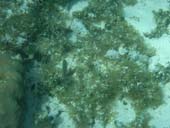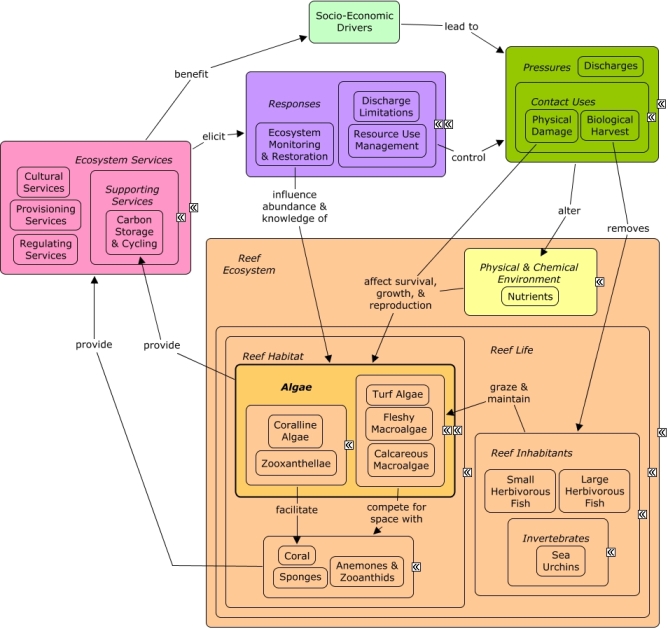ReefLink Database

Algae
Algae are aquatic, photosynthetic plant-like organisms and include calcareous macroalgae, fleshy macroalgae, turf algae, and crustose coralline algae.
CMap

CMap Description
Macroalgae and turf algae compete for space with coral, sponges, and other species. Excess nutrients may alter competitive interactions among algae and coral. Many fishes and invertebrates are key grazers, helping to maintain algae and prevent it from overgrowing coral. A number of algal species, including calcareous macroalgae and crustose coralline algae, deposit calcium carbonate during growth, and may contribute to reef structural strength. Crustose coralline algae may help facilitate recruitment of stony coral. Algae are primary producers, and provide some habitat and resources for marine fish and invertebrates, however often not to the same degree as stony corals, octocorals, or sponges. As a result, overgrowth of coral reefs by algae will likely result in a loss of ecosystem goods and services. Many of the sectors that benefit from reef ecosystem services also contribute to algal overgrowth through pollution and overfishing. Monitoring, mapping, and scientific research can be used to track the distribution and abundance of algae, and to understand competitive interactions between coral, algae, and other species.Citations
More than 50 citations. Click here to load.
| Citation | Year | Study Location | Study Type | Database Topics |
|---|
Management Options
| Management Option | Description | Sources | Database Topics |
|---|---|---|---|
| Agriculture & Aquaculture: Bivalve Aquaculture Biofouling Control | These management options reduce, clean or remove biofouling organisms and other waste from bivalve production areas while minimizing environmental risk. Aquaculture shellfish production requires adequate food availability and water of dependable quantity and quality. Aquaculture operations and gear must have a minimal adverse impact on the surrounding water, plant, animal and human resources. Biofouling is detrimental to shellfish production, increasing exposure to pathogens, reducing the available food stuffs, and increasing organic loading. Only environmentally appropriate biofoul control methods should be used, and fouling organisms and algae should be disposed of appropriately to avoid local degradation. | Natural Resources Conservation Service. 2011. National Handbook of Conservation Practices. U.S. Department of Agriculture. Natural Resources Conservation Service. 2011. Conservation Practice Standard: Bivalve Aquaculture Gear and Biofouling Control. CODE 400, USDA. |
Algae; Aquaculture; Arthropods; Artificial Habitat; Biological Addition; Biological Harvest; Bivalves; Chemical Variables; Discharge Limitations; Domestic Animal Waste; Escape & Release of Non-natives; Finfish & Shellfish Stock; Food & Energy Policies; Food & Raw Materials; Improved Technology; Invertebrate Harvest; Lobster, Crab, & Shrimp; Molluscs; Non-point Source Controls; Nutrient & Contaminant Processing; Octopus & Squid; Point & Mobile Source Controls; Snails & Conch; Supplemental Feeding |
| Discharge Controls: Carbon Sequestration | Carbon sequestration is the process through which practices remove carbon dioxide (CO2) from the atmosphere. The term "sink" is also used to describe agricultural and forestry lands that absorb CO2, the major global warming gas emitted by human activities. Agricultural and forestry practices can also release CO2 and other greenhouse gases to the atmosphere. In the ocean, phytoplankton are another major carbon sink. | Houghton, R.A. 2002. Magnitude, distribution and causes of terrestrial carbon sinks and some implications for policy. Climate Policy 2:71-88. |
Agriculture; Agriculture, Aquaculture, & Forestry Policies; Algae; CO2; Deforestation & Devegetation; Forestry; Funding & Incentives; Greenhouse Gas Emissions; Infrastructure; Landuse Management; Plankton; Political Pressure; Solid Waste Disposal |
| Monitor & Research: Detect and Respond to Episodic Events | Sanctuaries should have centralized information about algal blooms, fish kills, large patches of discolored water, and other unusual episodes to determine whether a management action would be appropriate. For such decisions to be made in a timely fashion, monitoring data must be consistently collected and updated in the information system #203. This monitoring information can than be added to a #166, where models like those planned out in #207 can determine the degree of threat and where it may spread. | NOAA Marine Sanctuary Program. 2007. Florida Keys National Marine Sanctuary revised management plan. National Ocean Service, Key West, FL. |
Algae; Biological Monitoring & Restoration; Biological Monitoring, Mapping, & Scientific Research; Chemical Variables; Decision Support; Ecosystem Monitoring & Restoration; Fish; Physical Variables |
| Monitor & Research: Biological Status and Trends Monitoring | This activity produces long-term comprehensive information on sanctuary-wide status and trends of biological resources. Data that could be collected on coral reef communities includes but is not limited to species abundance and density, biodiversity, benthic cover, coral condition, growth, recruitment, predation, and grazing. Mangroves and seagrasses should also be monitored. With adequate baseline data, changes in community structure and biocriteria can be identified and restoration or protection efforts can be taken. | NOAA Marine Sanctuary Program. 2007. Florida Keys National Marine Sanctuary revised management plan. National Ocean Service, Key West, FL. |
Algae; Anemones & Zooanthids; Apex Fish Predators; Aquaculture; Aquarium Stock; Biochemical & Genetic Resources; Biocriteria; Biological Harvest; Biological Monitoring & Restoration; Biological Monitoring, Mapping, & Scientific Research; Bivalves; Calcareous Macroalgae; Contact Uses; Coral; Coralline Algae; Cyanobacteria; Decision Support; Echinoderms; Ecosystem Monitoring & Restoration; Finfish & Shellfish Stock; Fish; Fishing Sector; Food & Energy Policies; Hydrocoral; Invasive Species; Invertebrates; Large Herbivorous Fish; Lobster, Crab, & Shrimp; Mangroves; Marine Birds; Marine Products; Marine Vertebrates; Marine Worms; Microorganisms; Molluscs; Octocoral; Octopus & Squid; Ornamental Jewelry & Art; Pathogens; Pharmaceuticals & Cosmetics Sources; Physical Damage; Primary Production; Provisioning Services; Resource Use Management; Sea Turtles; Sea Urchins; Seagrasses; Seastars; Skeletal Coral; Small Herbivorous Fish; Snails & Conch; Sponges; Stony Coral; Tunicates; Wetlands; Whales & Dolphins |
| Restoration: Removal of Invasive Algae | Benthic organisms on reefs maintain a delicate balance competing for space. In many areas, the competition between coral and algae has fallen out of balance due to confounding factors. Factors such as decreased herbivorous fish and invertebrates, and invasive algae species have allowed faster growing algae to take over many reefs, often growing into smothering mats that cover and kill coral. In Hawaii, there has been some success physically removing invasive algae such as Kappaphycus using underwater vacuums extended down from barges or volunteer events in shallower areas. | The Nature Conservancy. 2010.Two Million Pounds of Invasive Algae Removed From Maunalua Bay. (not cited) |
Algae; Aquaculture; Biological Addition; Biological Harvest; Biological Monitoring & Restoration; Biological Monitoring, Mapping, & Scientific Research; Calcareous Macroalgae; Collaboration & Partnering; Coral; Coralline Algae; Decision Support; Ecosystem Monitoring & Restoration; Escape & Release of Non-natives; Fishing & Harvesting Management; Fishing Sector; Fleshy Macroalgae; Hydrocoral; Invasive Species; Large Herbivorous Fish; Octocoral; Reef Habitat; Skeletal Coral; Small Herbivorous Fish; Stony Coral; Turf Algae; Wetland & Reef Restoration; Zooxanthellae |
| Stormwater BMPs: Sustained Reservoir Minimum Release of Minimum Baseflow to Sustain Aquatic Habitat | In some regions, even high intensity rivers (e.g. Rio Loco, Puerto Rico) are seasonal, drying for long enough to kill aquatic vegetation. Creating a constant baseflow would help sustain aquatic life and ultimately help to process nutrients. High intensity rivers are already prone to extreme channel erosion from the high flow rates, this erosion is even greater without any benthic biota to hold sediment on the river bottom. Restricting the release of reservoir water to that required to maintain aquatic biota would reduce the intensity of flow, stabilize the river bottom, create habitat and naturally process nutrients that could potentially contribute to eutrophication out on the coral reef. | Center for Watershed Protection. 2008. Guanica Bay watershed management plan. Natural Resources Conservation Service. 2011. National Handbook of Conservation Practices. U.S. Department of Agriculture. |
Algae; Biological Monitoring & Restoration; Climate; Dam Construction & Maintenance; Discharge Limitations; Discharges; Ditching & Soil Disturbance; Drinking Water Supply; Ecosystem Monitoring & Restoration; Hydrologic Management; Infrastructural Policies; Infrastructure; Land-Based Civil Engineering; Landscape Changes; Landuse Management; Nutrient & Contaminant Processing; Physical Variables; Point Source Discharges; Pressures; Primary Production; Reef Habitat; Reef Life; Regulating Services; Storms & Hurricanes; Stormwater Management; Surface & Groundwater Flow; Utilities; Waste Management; Water; Waterborne Discharges; Wetland & Reef Restoration; Wetlands |
Laws
| Legal Citation | Purpose of Law | Management Organization | Database Topics |
|---|---|---|---|
| Marine Sanitation Devices (MSDs); Regulations to establish a No Discharge Zone (NDZ) for State waters within the boundary of the Florida Keys National Marine Sanctuary,Code of Federal Regulations § 40 CFR Part 140, 67 FR 35735. | US EPA established a no discharge zone within the boundaies of the FKNMS pursuant to section 312 (f) (4) (a) of the Clean Water Act. Application to Coral Reefs:Prohibition of waste discharges protects reefs system from eutrophication by the nutrients in waste (particularly nitrogen and phosphorus) as well as the debris and sediment in the waste. Legislative Actions: Comments: |
US Environmental Protection Agency Jurisdiction: US Coral Reefs; US Federal Waters; State Coastal Waters; Designated Marine Areas |
Algae; Ballast Discharge; Commercial Fishing Boats; Cruise Ships; Large Ships; Marine Debris; Nutrient & Contaminant Processing; Nutrients; Oil & Gas Tankers; Pathogens; Petroleum Spills; Physical & Chemical Water Quality Criteria; Small Boats; Waste Management Policies; Wastewater Discharge |
